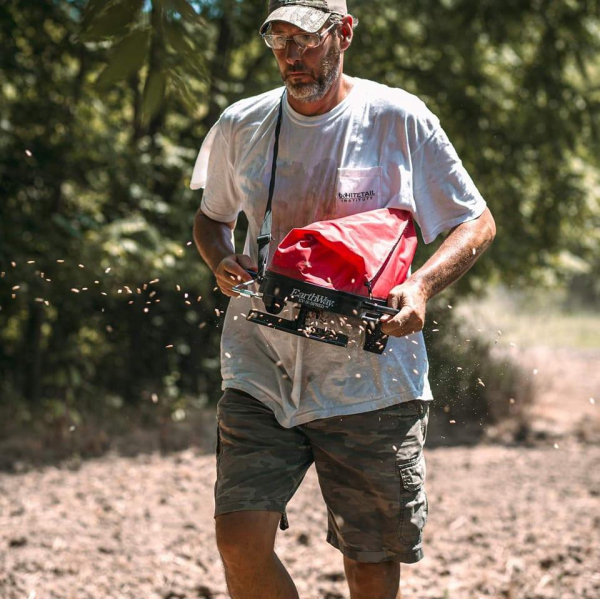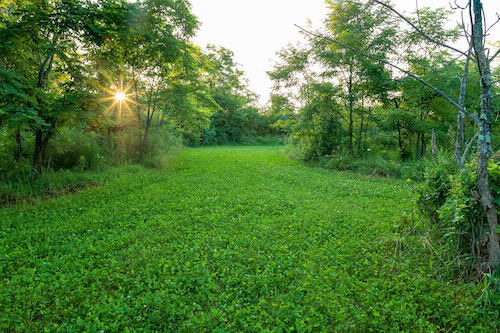

|
Whitetail habitat expert and ScentLok pro, Jason Say, properly proves that creating a functional food plot is well inside your wheelhouse
The whitetail deer is the most popular game animal in the US, so it should be no surprise hunters spend plentiful time and money throughout the year on whitetail related matters. Firearm and archery equipment, treestands and blinds, optics, and of course clothing specifically engineered for hunting deer are all investments hunters justify annually, which is easy to do considering how technological advancements have tilted the advantage to hunters like no other time in history.
But once the season grinds to an end, you’d think deer hunters would give the old wallet a rest for a few months, but no, whitetail fever does not subside and preparation for next season commences almost immediately. While the extra time, money, and effort certainly don’t guarantee success, it sure doesn’t hurt to cross the t’s and dot the i’s, and food plotting is one of the things many hunters implement annually – which is also a meaningful way to stay invested in the deer hunting lifestyle year-round.
Most hunters assume they don’t need to supplement the forage deer already have available to them, and with heavily farmed countryside throughout much-of whitetail country, it’s not hard to convince yourself food plots aren’t necessary. The fact is, though, regardless of where you hunt, food plots can be beneficial to deer by maximizing the potential to cross paths with a trophy whitetail buck.
Anyone who has planted food plots knows there are varying degrees of success, and it is often based on the amount of sweat equity you put into preparation and planting food plots. However, the necessary measures to ensure such success are not always practical – whether a matter of logistics, timing, or more commonly, a lack of implements and equipment.
Located in northwest Pennsylvania, about 40 minutes from the Ohio border, ScentLok Pro Jason Say is the host of All In Outdoors (YouTube, CarbonTV) and the popular Field Days podcast. He is also a consultant specializing in maximizing trophy whitetail potential on private land, including food plotting.
Say tends to some of the lushest food plots you will ever see. You could say, Say got into food plots big time, but it wasn’t necessarily always that way.
“I want everybody to be able to food plot no matter what equipment they have. I started with almost no equipment, and you can invest in better equipment as you progress,” said Say. “I got hooked, and now I have a drill, tractor, disc and mowers – things like that, but I didn’t start out like that.”
Say explained the four levels of food plotting: “Start out with hand tools. The next step is still using some hand tools, but also step up to a quad and drag harrow. Level three is a chisel plow for the quad, and eventually you end up with a tractor and all the implements.”
Like many food plotters, Say started by scraping together a few basic tools and others he could borrow. In some cases, he and his buddies hiked into remote spots and used hand implements to clear areas and plant them.
“The easiest way is to use nothing but a hand sprayer (for herbicide), hand sickle, garden rake, and a seed spreader,” Say explained. “We did an 8th acre plot and each time in we’d haul lime and manure with us. We couldn’t get a four-wheeler back into the spot, so we’d just carry buckets full.”
The master-of-plots says, like anything else, the more steps you do generally the better the result, “We simply sickled the vegetation and when it started to grow back a little, we sprayed it with 41% glyphosate. Eventually, it was pretty much bare dirt. When we were ready to plant a couple weeks later, we roughed it up with a garden rake, spread lime and fertilizer, and eventually seeded – it was a ton of work and a lot of sweat equity, but it ended up being a great food plot.”
The next step up is doable for hunters who have a degree of equipment. “I’ve planted a ton of food plots with nothing but a sprayer, four-wheeler, drag harrow, and a seed spreader…and still do plots like that. If I cannot get a quad and a chisel plow through a creek or over something, I just take the four-wheeler and drag harrow into the spot. Those are two great ways to do food plots on a budget.”
“Let’s say you have a four-wheeler and a drag harrow – you can make one with the box springs from an old mattress, or wood pallets; I have a steel one from a farm store. I’ve planted a lot of food plots this way…same thing, clear it with a sickle or a weed whacker, rake the weeds out and spray it with the glyphosate, and then go back three or four times and drag it with a harrow because all you need for food plot is a little bit of seed/soil contact. People think you must have this beautiful seed bed, and it must be perfectly level, but nothing could be further from the truth,” added Say.
He also emphasizes the importance of having soil samples analyzed. “Samples take out the guesswork, and to me, they are very important, and I have my plots sampled every single year. Lots of guys think they know their dirt, but many times I’ve seen the PH change, and if your soil PH is not where it needs to be, then plants cannot absorb the nutrients they need to thrive and you’re wasting time and money.
Food plots don’t have to be huge or extravagant, either. In fact, the most effective ones can be rather small according to Say, “I’m a huge proponent of small kill plots. The average size of my food plots is a quarter acre. I have killed three of my biggest bucks – 150, 154, and 148 inch PA bucks – on an eighth acre food plot. There isn’t a stitch of corn or soybeans on my property.”
Huge ag fields full of grain crops and even hayfields draw a lot of attention from deer. The beauty of a small food plot nearby is, the forage is not only unique and often desirable, but food plots also serve as a staging area for deer in a relatively small area that affords hunters an ideal shot.
“You’re not going to compete with corn and soybeans, but a lot of the time I’m planting an eighth of an acre plot in between the cover and a crop such as corn. These small kill plots are located between the bedding cover where they are, and the food, which is where they want to go,” Say explained. “I have corn and soybeans around me, which are preferred browse, and when deer initially come into my plots, they’re going to be messing around there during daylight hours before they hit those preferred forage destinations at night.”
Say also spends a lot of time planning his plots so they maximize their potential in ways a lot of hunters fail to recognize, “Anyone who wants to plan food plots needs to think about how they are going to kill a deer. How is this going to help me do that? How am I going to get in and out of it? Am I going to catch them on their way in or sit right on it…I sit right on it?”
He continued, “A lot of my food plots are semicircles or squares, because when the deer steps into it, it’s already in range. I’ll even put barriers up behind me and out in front of me so deer of must come in broadside offering perfect shots. This is easy if you must clear an area and push the trees off to the side. You can use those for this sort of thing. Take the time to analyze the place where you going to do the food plot and how you’re going to kill the deer.”
ABOUT NEXUS OUTDOORS
Nexus Outdoors, headquartered in Muskegon, MI, USA, is a leading worldwide designer, marketer and distributor of performance, hunting and casual odor-controlling apparel, footwear and equipment under the ScentLok Technologies®, OZ®, Blocker Outdoors®, Whitewater Fishing® Hardcore® Waterfowl, TUO, and Tree Spider® brands. It also owns American Range Systems, manufacturer and distributor of the world’s strongest and safest bullet traps. Nexus Outdoors is the only company with access to all scent-controlling technologies, including their patented Carbon AlloyTM and Cold Fusion CarbonTM technologies, which provide superior success in the field. ScentLok and Blocker Outdoors are pioneers in the hunting industry, which many credit with creating a market focused on superior scent control to get closer to big game.
MEDIA CONTACTS:
Jay Anglin
Traditions Media, LLC